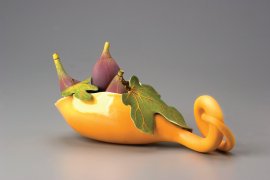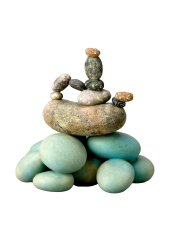 How
could a show of teapots be extraordinary? Wouldn't that be like
having an exhibition of kitchen appliances?
How
could a show of teapots be extraordinary? Wouldn't that be like
having an exhibition of kitchen appliances?
We all have an image of a teapot, but these are not those teapots. Teapots: Object to Subject, the current show at the Figge Art Museum, is like a Mad Hatter's tea party.
Most of the 49 pieces in the exhibit are functional and use the required elements of the teapot form that has remained unchanged for centuries: a spout that pours, a handle that can be held, a lid that opens, and a belly that doesn't leak hot water. Within these essential restraints, though, the works leap out from the other side of the looking glass with inventive surfaces and forms, constantly surprising the viewer. The exhibit includes everything from opaque political commentaries to uneasy life experiences to subtle interpretations of existence.
In the back of the gallery are the sexy ones, two each by Richard Swanson and Chris Gustin, playing on the idea of the teapot as a metaphor for the human body. Swanson creates embracing and corpulent Botero-like figures in his slip-cast Pleasure That Burns, which is covered in a chocolate-brown matte glaze. That these could hold steaming water and actually pour is superfluous, for their ecstatic nature.
Gustin, in his teapots #9525 and #9103, seems to have captured the essence of tender flesh with its intimate folds and curves. One has to figure out where the handle and spout are. Looking like organic inner and outer body shapes, we're not sure if this representation is from life, or imagination, or both. The idea of the teapot has been submerged into sculpture.
This seems both a joy and a disappointment, like verse without boundaries, for the best of the exhibition's pieces touch both worlds simultaneously. Their delight is in being a teapot and a creation; the limitation is part of the art.
In Carrianne Hendrickson's marvelous Sea of Duplicity, a pale woman stoically floats on unseen waters wearing a swim cap, suit, and thick red goggles. Only her head, arms, and torso are visible. She is buoyed in a yellow inflatable that spouts two wide-eyed animal heads that are the handles. One is a smiling fanged doe, and the other a scrutinizing buck with horns. A long animal tail thrusts out behind her from the inflatable, serving as a balancing spout. Floating, she is protected but also confined by these two bodyguards. This experience has nothing to do with tea, and everything to do with survival and self-protection. The artist has given us a sensitive portrait of the human condition, neatly concealed in the appearance of a teapot.
 One
of the great qualities of clay is its ability to give the illusion of
any material. Near the center of
the gallery are two little
porcelain jewels by Claudia
Tarantino. In Figs & an
Orange Twist, the clay
looks like soft, purplish fruit and tender green leaves with thin
yellow and orange veins. A long, elegant orange twist spirals out as
a boat that the three fig travelers can sail away on. The leaves are
draped over as protection or a let-down sail. A tiny hole in one fig
is the pour spout, and the long curl is the handle. Here in miniature
is a children's story, witty and whimsical, of delicate
proportions.
One
of the great qualities of clay is its ability to give the illusion of
any material. Near the center of
the gallery are two little
porcelain jewels by Claudia
Tarantino. In Figs & an
Orange Twist, the clay
looks like soft, purplish fruit and tender green leaves with thin
yellow and orange veins. A long, elegant orange twist spirals out as
a boat that the three fig travelers can sail away on. The leaves are
draped over as protection or a let-down sail. A tiny hole in one fig
is the pour spout, and the long curl is the handle. Here in miniature
is a children's story, witty and whimsical, of delicate
proportions.
A similar lighthearted delight is Barbara Frey's Let's Go Teapot. This porcelain teapot seems to be made out of three piles of realistically glazed stones that could have been gathered from a lake shore and stacked up magically. At the lower level 16 rocks are glazed in a soft robin's egg turquoise; the next level is a single stone of baked potato tan; and the top pebbles, striped or in multiple colors, are gathered to form an acrobatic arched handle, lid, and spout. That they are really made out of porcelain is surprising. This enjoyable leap of material communicates an amusing suspension of gravity, as if the pebbles were caught and held in a flight of joy and at the same time could actually pour tea.
Two intriguing works are found nearby in Nancy Selvin's poetic personifications Teapot #0104 and #9901, both displayed on dark metal trivets. Willowy and elongated pear-shaped spouts are attached to irregular dome shapes; one pot is tall and slender, while the other is short and stout. They look like works in progress; the attached parts have an almost unfinished look at first, as an area in a Sargent painting is suggested with a few sweeps of a loaded brush. Yet her work is perfectly finished - that is her style.
#0104 is sketchy, standing off-kilter, quietly fragile. The skin has been incised and rubbed with lines of hard experience. The surface holds softly brushed glazing, partially erased, and the spout and the handle, circled by quick lines of gesture, seem stuck on at the last moment, like a sudden and uncertain decision.
# 9901 is similar: the long spout, an eroding handle, a little nipple of a lid, awkwardly pierced and held on with a metal wire, and dark turquoise lines marking the boundaries of shapes. Both vessels have an unexpected presence, like pensive teapots from a Tim Burton film.
 There
are two witty and painterly homages to art history by the Russian
émigré Noi Volkov. One is a portrait of Picasso with
his piercing eyes, glazed in the artist's own style, and the other
is a close-up of the face in Botticelli's painting The
Birth of Venus. In
Picasso,
we see references to his strong brushstrokes in the portrait and his
yellow, blue, and white stripes in the spout and handle. Sitting on
top of it all are a red, four-eyed cubist bull
and a languid reclining
nude woman, with dust-mop toes, orange hair, and three breasts. The
bull and the woman open as the lid.
There
are two witty and painterly homages to art history by the Russian
émigré Noi Volkov. One is a portrait of Picasso with
his piercing eyes, glazed in the artist's own style, and the other
is a close-up of the face in Botticelli's painting The
Birth of Venus. In
Picasso,
we see references to his strong brushstrokes in the portrait and his
yellow, blue, and white stripes in the spout and handle. Sitting on
top of it all are a red, four-eyed cubist bull
and a languid reclining
nude woman, with dust-mop toes, orange hair, and three breasts. The
bull and the woman open as the lid.
On Venus, the enigmatic face of the goddess is sculpted into the body of the pot. Her flowing hair turns into a large two-fingered handle, and the pot's lid is Venus' seashell holding a single pearl. Both of these small sculptures were made from a mold in a series of 30, individually glazed. The great pleasure of seeing these two icons of art as teapots comes from their cultural familiarity and a visual delight in the playful use of color, surface, and shape.
A handful of the works are most obviously teapots, with all parts clearly defined. There are eight of these instantly recognizable ceramic pots made by four artists in the far back left of the gallery, huddled together like the remnants of an old guard. These are your archetypal wheel-thrown teapots, some wood-fired. But even within them is irony.
Michael McCarty is represented by two shapely ginger-jar porcelain vessels. In Teapot 1 (pictured on the cover of the brochure), an elegant feminine teapot body is connected awkwardly with an oversize ear-shaped handle and a long, unevenly bent pour spout. They have a strangely appealing accord, like the union of two different worlds, one of harmony and the other exaggerated and rough, just like the marriage of interesting opposites.
A pleasing cubist teapot appears in the landing by the elevator, a tightly packed explosion of flying celadon shapes that has suddenly been released. Everything is in motion but held in a moment of time - the dancing sides, the little circling spout angling its way up, and the handle and lid both soaring. But the composition of curves, holes, partial spheres, and a solid little base make for a balanced whole, filled with energy. This teapot could warm the water itself.
At the entrance of the exhibit stand two surreal trompe l'oeil earthenware vessels, looking bigger and deeper than they really are. Here the artist has reversed normal procedure in making a three-dimensional object trying to appear two-dimensional. Ringed Finger Teapot by Louis Marak shows overlapping male and female hands inside a thickly glazed box lantern, each hand wearing a spiraling bracelet for the handle and the spout. Glazed water flows from over the top of the lantern, but not from inside. His other piece, Avian Teapot, shows a frightened bird captured in the illusion of multi-layered barrels again overflowing with water. A long, seemingly unattached tube winds its way through as both the spout and the handle. Thick drops of glaze as water run over the lid. In both, everything living is overwhelmed, contained, suffocating. Here the tension between masterful ceramic technique and a disturbing environmental commentary is high.
One could hardly visualize ever serving tea with any of these teapots as if they were a normal part of our existence; one would have to build a room full of personal eccentricity just to accommodate even one.
Be sure to take your time going through the exhibit, for there are dozens of other skillful objects that reveal more with each viewing.










